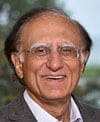
Thought Leadership
How do you unleash your people's potential? Blank checks
Among the many management questions an effective leader must answer, one of the most important is this: “What must I do to help my executives achieve success in their efforts?” According to Sanjay Khosla, Senior Fellow and Adjunct Professor of Marketing at Kellogg and co-Academic Director of Executive Education’s Delivering Business Growth: an Actionable Framework, it’s very simple. Give them free rein — within a framework. Or, as Khosla terms it, give them a blank check. Then let them run things their way.
“The leadership insight is to find the right people, give them the right resources and then get out of the way,” said Khosla, who has used the method successfully for the past 15 years. “It has worked extremely well across industries, independent of where people are in the organization.”
According to Khosla, this method yields spectacular results. During his time at Kraft Foods (now Kraft Heinz), he gave blank checks that allowed employees to grow their businesses dramatically. in the Kraft Developing Markets division, Oreo went from $200 million to $1 billion in revenue in six years. Tang grew from $500 million to $1 billion within five.
The Three Phases of Receiving a Blank Check
“Whenever you give a blank to check to anyone, the person looks at you like you’re nuts,” Khosla said. “It very quickly leads to panic. Internally, they’re saying, ‘Oh, my God — what do I do? This guy’s serious; it’s not a joke!’ ”
After the initial shock, recipients are spurred to action and go through three stages:
- Time crunch: due to pressure to deliver results, people focus on where they can win.
- Distort resources behind priorities: interestingly, the most important part of resource allocation is talent and people, followed by time and money.
- Execution: start making things happen after the priorities are agreed upon. Test and learn, and quickly scale whatever is working. If you fail, as you often will, fail quickly, learn, and move on.
The Blank Check in Action
Success stories from past Executive Education participants abound, according to Khosla. One example he highlighted happened when Khosla was Managing Director of Fonterra Brands, one of the largest dairy companies in the world. The global food-service business was underperforming when George Zoghbi took the helm. He was given a blank check to take the business from $800 million to $1 billion NZD and then continue growing at that rate.
In phase one, Zoghbi focused on markets where he thought he could move the needle. Then, during the assessment phase, he hired the people who would help him achieve his goals. Finally, he pinpointed the customers and products he needed to target.
In the first year, Zoghbi grew the division to more than $1 billion NZD, exceeding his assigned goal. Not only did he achieve phenomenal results, he grew as a person, Khosla said. In addition, his team grew in experience and knowledge because they were forced to be creative, take ownership and be entrepreneurial in a pressure-cooker situation. Zoghbi eventually became Chief Operating Officer of Kraft Heinz, responsible for an $18 billion business in North America.
Blank checks’ lessons for managers
Trust people: let go of the command-and-control model. Find the right people, and get out of the way.
Accept failure: the process doesn’t always work. If everything is going well, something is wrong. Allow people to fail fast and learn. Then move on. If you do that and redeploy them to assignments that are equally important, it sends a signal that it’s all right to fail—so long as the person does not fail too often.
Blank checks let people grow, Khosla stressed. By holding your team accountable and encouraging entrepreneurship within your organization, they’re more likely to grow beyond their comfort zones. And that’s the best dividend an executive could hope for from any investment.
Visit here for more information on Blank Checks.
 |
Sanjay Khosla is a Senior Fellow at Northwestern University's Kellogg School of Management and a Senior Advisor at Boston Consulting Group. He teaches in a variety of Kellogg Executive Education programs, including Delivering Business Growth and Kellogg on Branding. He is the co-author of Fewer, Bigger, Bolder with his colleague Mohan Sawhney. |
Delivering Business Growth
Emphasizing action, this program teaches a market-tested framework that has delivered sustained double-digit growth in revenues and margins for major global brands. You’ll leave with a business growth strategy and actionable agenda for driving growth within your organization.
Upcoming Sessions
|
June 2-5, 2025 Start: June 2 at 1:00 PM End: June 5 at 11:45 AM
Click here for Executive Education's COVID-19 health and safety protocols |
$9,000 Fee includes lodging and most meals |
|
|
October 27-30, 2025 Start: October 27 at 1:00 PM End: October 30 at 11:45 AM
Click here for Executive Education's COVID-19 health and safety protocols |
$9,000 Fee includes lodging and most meals |
Related Programs
Advanced Management ProgramKellogg on Branding
The Customer-Focused Organization



